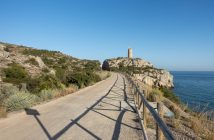From one to several days, on easy or difficult tracks, these cycle tours cater to the needs of all styles of cycling. Choose from our pick of trails, taking you from the olive groves of southern Córdoba to the Picos de Urbión mountains, crossing sand dunes, narrow Asturian mountain passes and many other terrains.
- Subbética Green Way (or ‘Olive Trail’), Cordoba.
This long, comfortable bike ride through the mountains south of Cordoba partly follows the route of the old Oil Train and looks out over beautiful olive trees, a lagoon bursting with birdlife and Zuheros, one of the prettiest villages in Spain. You will also pass grand iron bridges, built in a similar style to the Eiffel Tower. What shouldn’t you miss? The train station in Luque, where you can eat at the restaurant on the station platform, and the station in Cabra, which houses the Oil Train Museum and unusual machinery.
Details of the trail
This is a linear trail of 65.25km along a green trail in fairly good condition and barely any change in altitude. The biggest difficulty will be the high temperatures, as in summer the Salobral Lagoon is dry.
- Tour of Fuerteventura, Canary Islands
The arid, wild place called Fuerteventura offers ideal conditions for a circular bike tour over several days. This is thanks to its accessibility, excellent climate, quiet road traffic and cycle paths with breath-taking views, as well as the dune park around Corralejo beach; the beautiful vistas from the Calderón Hondo volcano, or the lava flow of Malpaís Chico. The suggested trail starts and ends in Puerto del Rosario, looking out at the surf waves around the Tostón lighthouse and the El Cotillo cliffs, in the north-west of the island. It continues along spectacular roads, such as the one linking Tindaya Mountain with La Pared over the course of two challenging days, passing through Betancuria and the Las Peñitas lookout point. It also offers some attractive detours, such as a trip to the fossilised sand in Peña Horadada in Ajuy or taking a selfie in front of the Degollada Agua Oveja, or in the wild landscape of Jandía.
Details of the trail
257 kilometres and 2600 metres altitude change, divided over six stages, over dirt tracks, paved roads and cycle paths. Even though it doesn’t sound like a long trail over six days (ideal length), the changes in altitude and the state of the trails can make it tough going. It’s a good idea to include rest days as you go, to preserve your strength and enjoy the views. October and November are the best time of year for this trip, as there is less wind, longer days, moderate warmth and quieter roads.
- Picos de Urbión and Tierra de Pinares, Soria
The Picos de Urbión and Tierra de Pinares in Soria are perfect areas for mountain bike touring. Mainly because of the challenge of this three-day tour, given that the aim is to climb the peak of Urbión, 2200m altitude change. You will also cycle along forest paths and simple trails that follow old Roman roads, cattle tracks and the footpath that winds through the limestone outcrops of the Rio Lobos canyon, the Cueva Grande and the San Bartolomé hermitage. During the ride, you will admire such natural monuments as La Fuentona and the unusual Sabinar de Calatañazor forest.
Details of the trail
A circular route that starts at El Burgo de Osma, is 190 kilometres long and has three fairly challenging steep stages over various types of terrain.
- Tallinn and the islands of Hiiumaa, Saaremaa and Muhu, Estonia
There are many good reasons to cross Estonia by bike, but the most important one is that there are no hills. It’s an extremely flat country, full of trails, very little traffic, long hours of daylight and a perfect summer climate with an average temperature of 18 degrees. You can begin by cycling through the main square of Tallinn, carved in stone, then stop off at the Balti Jaama market, where you’ll find fruit stalls, antique vendors and hamburger stands. Take a boat trip across to the islands to the west of the country: Hiiumaa, Saaremaa and Muhu. At the southern tip of Hiiumaa, at Kassari, a strip of sand disappears gently into the sea, the perfect spot to watch the sunset.
Details of the trail
Most of the trail is on dirt tracks and paths, with no altitude change. There are cycle paths in almost all towns and villages, and those sections of the route that are on roads are very quiet. Another important detail: it’s easy to take your bike on the ferry.
- Picos de Europa, Asturias and León
From the Asturian beaches of Llanes to the heart of the Picos de Europa, this circular route gives you views over rugged cliffs and mountain passes such as Los Beyos. You will pass the viewpoints of Panderrueda, Pandetrave and the Llesba col, overlooking impressive ports such as San Glorio. Here it’s advisable to take your time and enjoy the majestic detours available on this route; such as Gulpiyuri beach and the ‘buffoons’ of Pría.
Details of the trail
A circular route of over 200 kilometres with 5200 metres of total altitude change that requires a high level of fitness and five days of cycling, interspersed with rest days. You will ride on mixed terrain, including quiet roads and dirt tracks in the downhill sections.
- Trans-Pyrenees trail. Girona to Gipuzkoa
This trail is probably the biggest cycle tour challenge in Spain. The Trans-Pyrenees is a long adventure, taking place over 16 or 18 days and spanning the largest mountain range in Spain. It requires a great deal of training and time, as it’s best not to rush. However, the rewards are huge, as you can surround yourself with overwhelming nature and enjoy a front row seat in the region’s diverse Pyrenean ecosystems. If you haven’t done a lot of training or you only have a few days, there are three stages that are fairly typical of this adventurous trail that you can cycle in Huesca province, from Seira to Larrés, cycling through sections with idyllic surroundings, such as the Cullivert mountain pass, overlooked by the rocky cliffs of Peña Montañesa on one side and the Circo de Armeña and the Cotiella massif on the other.
Details of the trail
The trail covers between 900 and 1000 kilometres, with 2000 metres altitude change. The tour can be divided over 16 or 18 stages of between 50 and 60 kilometres each, riding one stage a day. You can access several stages of it from various paths, with difficult terrain, so it is advisable to pack light and plan the tour well before setting off.






